We all know that the ecommerce landscape is constantly evolving.
New technologies, channels, and consumer expectations continuously drive businesses to update and improve their online offerings.
Over the past few years, one of the most popular buzzwords in ecommerce has been "composable commerce."
Table of Contents
- What is composable or modular commerce?
- Why enterprise brands are adopting composable commerce
- Composable commerce trends
- What are the key tenets of composable commerce
- Benefits of adopting composable commerce approach for enterprise ecommerce brands
- Busting myths about composable commerce
- 1. Myth: Using composable commerce solutions is complex and requires a lot of development effort.
- 2. Myth: Going omnichannel is difficult with composable commerce
- 3. Myth: Composable commerce solutions are not suitable for enterprise ecommerce brands
- 4. Myth: Tooling silos make it difficult to use composable commerce solutions
- 5. Myth: Business agility is not possible with composable commerce solutions
- Conclusion
What is composable or modular commerce?
A new way of thinking about ecommerce, composable commerce focuses on creating a modular, flexible platform that can be easily customized and adapted to the ever-changing landscape.
Believe it or not, modular commerce is not a new concept. The idea of assembling something out of smaller parts to create a larger whole has been around for centuries.
In the context of ecommerce, modular commerce refers to the ability to easily assemble and disassemble various software components to create a unique customer experience.
Composable commerce is a microservices-based approach that decouples different components, including the frontend and the backend of the ecommerce platform. Each component can be updated or changed independently—without affecting the others. For example: an enterprise brand can be using the same backend code nd logic to create new frontend for mobile commerce. It can go further and add different third-party softwares for automating its support, logistics, accounting etc. Any time any of these softwares can be easily replaced by new ones.
Fast-growing, high-volume, enterprise ecommerce brands can benefit significantly from composable commerce solution as it offers a high degree of flexibility and scalability.
Why enterprise brands are adopting composable commerce
Until a few years ago, monolithic architecture was the norm for enterprise brands building their ecommerce solutions.
This means that all components of the platform—including the shopping cart, order management, product catalogue, content management system (CMS), frontend design, and customer relationship management (CRM)—were tightly coupled.
With the monolithic approach, making even small changes to the platform could be a complex and time-consuming process.
For example, if you wanted to add a new payment method or shipping carrier, you would need to make changes to the codebase, which would then need to be tested, deployed, and released.
The problem with this approach is that it's inflexible and doesn't lend itself well to innovation.
In contrast, composable commerce platforms are built on a microservices architecture, meaning each platform component is a separate service that can be deployed and scaled independently.
Another issue with monolithic platforms is that they can be difficult to integrate with other systems.
Imagine you have a Lego set. With the monolithic approach, all the pieces are connected, so if you want to add a new piece, you must deconstruct the entire set and then rebuild it.
With the microservices approach, each piece is a separate block that can be added or removed without affecting the other pieces.
The three most common reasons why enterprises are adopting composable commerce are flexibility, scalability and innovation.
Composable commerce trends
By 2023, organizations that have adopted a Composable Commerce approach will outpace their competitors by reducing the time to market for new features and functionality by up to 50%.
Some more quick figures on composable commerce.
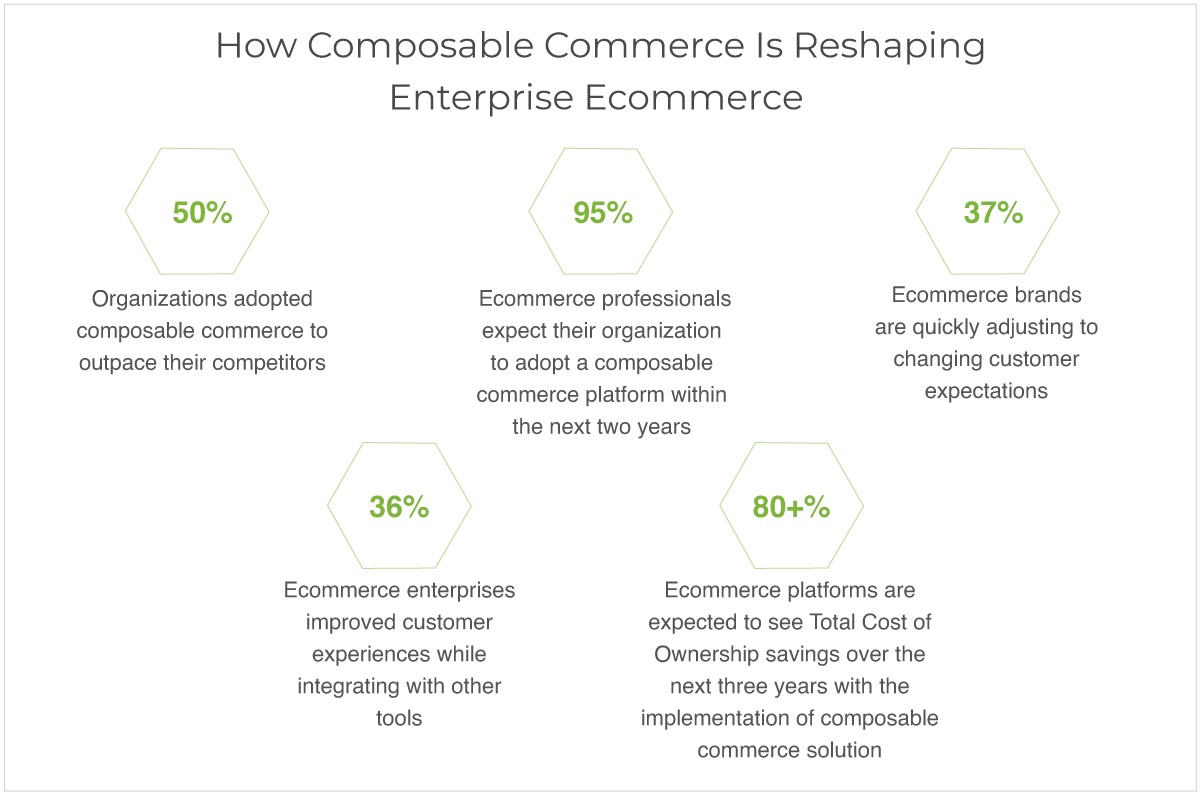
-
50% of organizations adopted composable commerce to outpace their competitors.
-
95% of eCommerce professionals expect their organization to adopt a composable commerce platform within the next two years.
-
37% of ecommerce brands are quickly adjusting to changing customer expectations
-
36% of Ecommerce enterprises improved customer experiences while integrating with other tools
-
80+% of ecommerce platforms are expected to see Total Cost of Ownership savings over the next three years with the implementation of composable commerce solution.
Source: Gartner
What are the key tenets of composable commerce
The 4 key tenets of composable commerce:
-
Modular architecture: The platform is built using small, independent modules that can be added or removed as needed.
-
APIs: Each module exposes APIs that can be used to communicate with other modules—or even third-party applications.
-
Decoupled components: The different components of the platform are not tightly coupled together, so they can be updated or changed independently.
-
Flexibility: The platform is highly flexible and can be easily customized to meet the unique needs of each business.
Benefits of adopting composable commerce approach for enterprise ecommerce brands
Here are the evident benefits of adopting the composable commerce approach for enterprise brands:
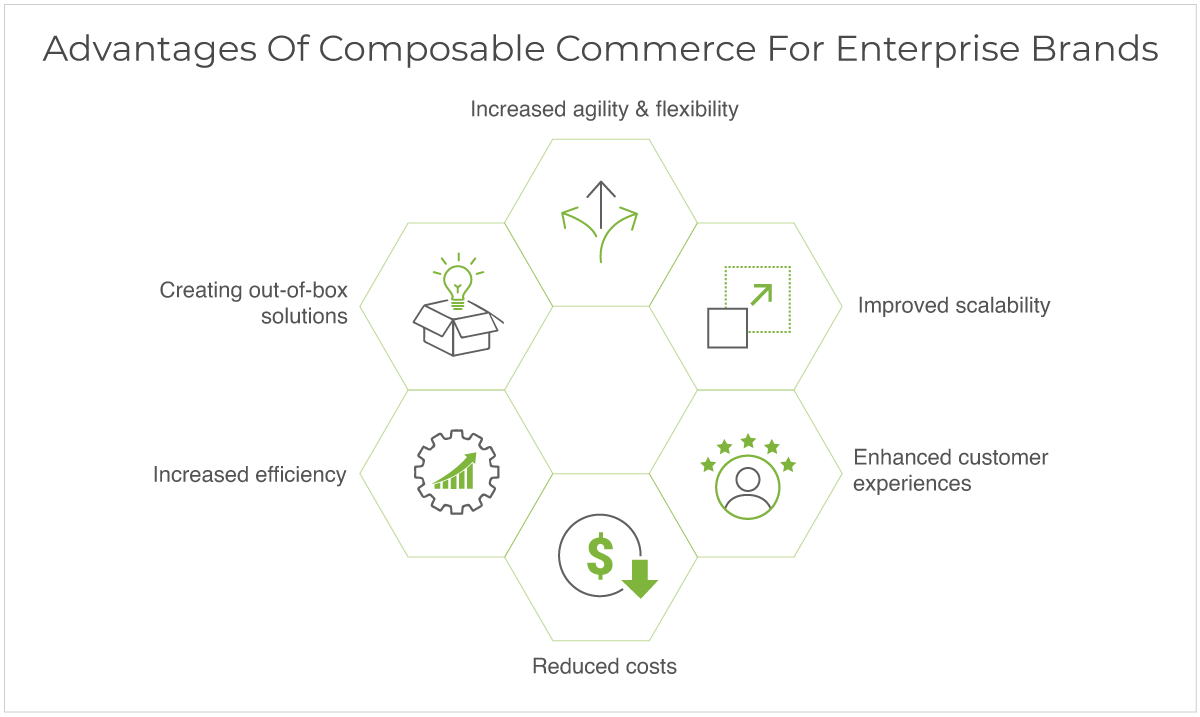
1. Increased agility and flexibility
With modular commerce, businesses can quickly and easily tweak their ecommerce website. They can also add new features and functionality as needed—without rebuilding their website completely.
2. Improved scalability
Modular commerce solutions are highly scalable. This means the business growth of brands is easily accommodated—without investing in additional infrastructure.
3. Enhanced customer experiences
Businesses can create a more personalized and seamless customer experience by decoupling different components of the platform. Customers can be served the most relevant content and products, regardless of their channel.
4. Reduced costs
Because composable commerce solutions are highly scalable and flexible, businesses can save money in the long run. They won't have to invest in new infrastructure as their needs change—and they can easily add or remove features as needed.
5. Increased efficiency
Composable commerce solutions are designed to be efficient. By decoupling different platform components, businesses can avoid duplication of effort and ensure that each team is working on the most important tasks.
6. Creating out-of-box solutions
By integrating with best-in-breed software and service providers, enterprises can quickly and easily create unique, out-of-the-box solutions that are tailored to their specific needs—without investing in custom development.
Enterprise ecommerce platforms are beginning to offer modular commerce solutions that enable enterprises to build the exact ecommerce experiences they need. These solutions allow enterprises to quickly and easily add or remove components as needed without having to rebuild their entire ecommerce infrastructure from scratch.
Enterprise e-commerce brands are lapping up the modular concept to unlock the power of flexibility, offer better customer experiences at a reduced cost, and create efficiencies in their business to be well-positioned in today's digital age.
Busting myths about composable commerce
Modular commerce solutions allow enterprises to integrate multiple systems and applications without requiring complex customizations or costly development efforts. This results in a more agile and adaptable organization that can quickly respond to market changes.
There is a huge shift from the traditional, monolithic commerce platforms that are difficult to customize and often require expensive professional services to make even small changes.
However, there is still a lot of confusion around what composable ecommerce is and how it can be used to power enterprise-grade online solutions.
To help you separate fact from fiction, we've debunked some of the most common myths about modular commerce. Here they are,
1. Myth: Using composable commerce solutions is complex and requires a lot of development effort.
FACT: One of the biggest myths about composable commerce is that it's complex and requires a lot of development effort, and this simply isn't true. Modular commerce solutions are designed to be simple and easy to use. They allow businesses to quickly and easily add or remove components as needed—without having to invest in complex customizations or costly development efforts.
For example, if you want to add a new payment gateway to your website, you can simply install the module and configure it without rebuilding your entire website.
The API-based solutions make it easy for brands to choose their preferred software solutions or service providers and easily integrate them with APIs.
Enterprise ecommerce brands can easily build their tailor-made solutions using StoreHippo's low-code environment.
2. Myth: Going omnichannel is difficult with composable commerce
FACT: With modular commerce, businesses can easily connect all channels—brick-and-mortar stores, online stores, marketplaces, and social media platforms—into a seamless, omnichannel experience. This means that customers can purchase products and services through any channel they prefer—and businesses can manage all of their channels from a single platform.
StoreHippo offers end-to-end omnichannel solutions to enterprise ecommerce brands of every size. Brands can create and add new customer touchpoints quickly using the same backend logic and APIs used for building the core website.
With StoreHippo platform, enterprise brands can easily connect all their channels—including brick-and-mortar stores, online stores, mobile apps, and social media platforms—into a single, seamless omnichannel experience.
3. Myth: Composable commerce solutions are not suitable for enterprise ecommerce brands
FACT: On the contrary, modular commerce enables enterprise ecommerce brands to use the best in breed software and solution providers to create a unique ecommerce environment for their brand.
For example, an enterprise brand planning to enhance its communications channels can use different SMS providers, email providers, chatbots etc. to connect with its clients.
Also, they can integrate with their chosen call centres to offer better customer support for their global clients. Similarly, the brand can use different service providers for handling different aspects of their business.
Such modular commerce solutions are the perfect fit for enterprise ecommerce brands.
Build the most innovative solutions easily by glueing together your ERP, CRM, accounting, marketing, and other third-party software with APIs with Storehippo’s MACH Architecture for Ecommerce.
With this, enterprise ecommerce brands can get easy access to extensively customizable, best-in-breed composable commerce solution by easily adding their preferred software and services.
4. Myth: Tooling silos make it difficult to use composable commerce solutions
FACT: Tooling silos can make it difficult to use modular commerce solutions—but they don't have to. With API-based solutions, developers no longer need to waste time trying to piece together different technologies that weren't meant to work together.
Early in the headless commerce movement, finding a single commerce solution that could provide all the functionality businesses needed was challenging.
Nowadays, there are plenty of options for best-of-breed, API-first commerce solutions that can be easily integrated to create a custom solution that fits your business's specific needs—without any unnecessary bloat.
For example, businesses can easily connect all disparate systems and applications- without the need for complex customizations or other development efforts.
Like an enterprise brand can use, mailing software from MailChimp, and accounting from Quickbooks while using StoreHippo as their ecommerce enabler.
Don't let tooling silos get in the way of your brand’s ecommerce success.
Choose an API-based, composable solution that will give you the flexibility and agility you need to stay ahead of the competition.
StoreHippo gives brands greater flexibility, agility and creative control with MACH Architecture for ecommerce. You can easily add or remove any third-party software or service without affecting the core functionality of your online store. You can also connect all your channels, systems, data, people, information etc. to improve business efficiency and collaboration.
StoreHippo also helps in implementing seamless buyer journeys across channels to enhance your user experience and create efficiencies for your ecommerce brand.
5. Myth: Business agility is not possible with composable commerce solutions
FACT: Monoliths feature a tightly coupled front- and back-end system. This means that if you want to change the front end, you have to change the back end—and vice versa. This can be a time-consuming and expensive process.
Think of it this way: would you rather have the flexibility to change your website on the fly or be stuck with the same look and feel for years?
Business agility is possible with composable commerce solutions because they are decoupled. This means that the front end and back end can be changed independently of each other—and quickly. So if you want to change the look of your website, you can do so without having to make changes to your back-end system.
This decoupled architecture makes it possible for companies to be much more agile and respond quickly to changing customer needs and preferences.
With StoreHippo, you get the best of both worlds: a modular, decoupled architecture that allows you to be agile, and a composable commerce solution that gives you the flexibility to tailor the user experience to your specific needs.
Additionally, StoreHippo's APIs make it easy to connect your existing systems and third-party applications, so you can create a seamless, end-to-end customer experience. StoreHippo also offers built in tools to build great UI/UX, helps with mobile optimization, and offers SEO features to improve your online visibility and website ranking.
Conclusion
Composable commerce solutions offer several advantages for businesses—including the ability to create unique customer experiences, and scale quickly and easily, without the need for costly customizations or development efforts. While there are some myths around composable commerce, the above facts show that this solution can be a powerful tool for businesses of all sizes. In addition, businesses that use composable commerce solutions can be more agile and responsive to changing customer needs and preferences.
The power and agility to create unique customer experiences are why StoreHippo is the best ecommerce platform for enterprises. With the ability to quickly and easily add or remove features and functionality, enterprise ecommerce brands can create a more personalized and seamless customer experience using the headless solutions from StoreHippo.
In addition, enterprises can also take advantage of StoreHippo's MACH architecture to connect all disparate systems and applications without the need for complex customizations or other development efforts. This gives enterprises greater flexibility, agility, and creative control when it comes to their ecommerce solutions.
So, if you're looking for a flexible, scalable, and easy-to-use ecommerce platform that makes composable commerce a reality for your enterprise brand, look no further than StoreHippo. Book your free demo right away to learn more about our composable commerce solutions.
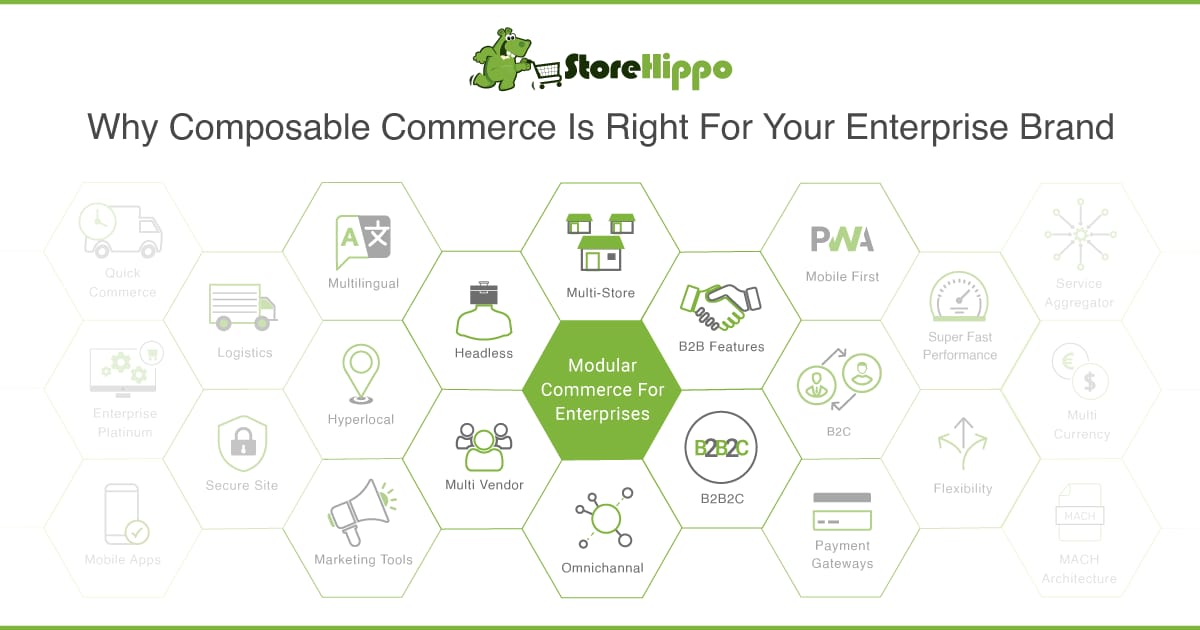

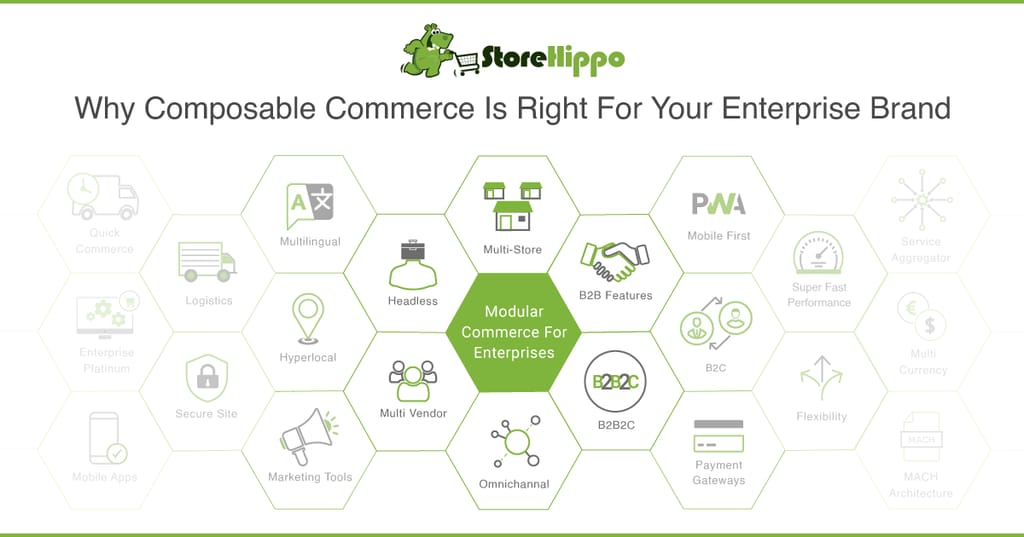



















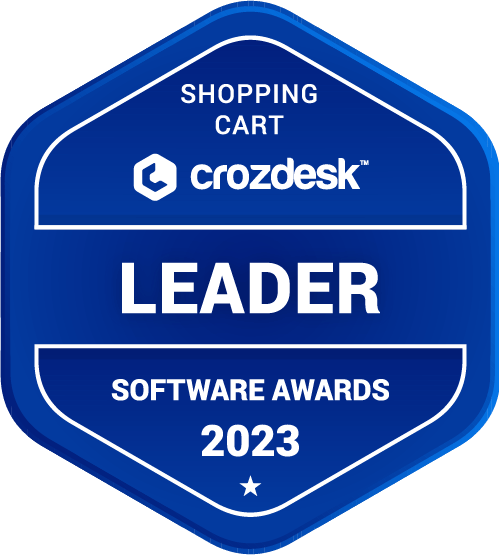
3 Comments
Leave a Reply
Leave a Reply
Leave a Reply